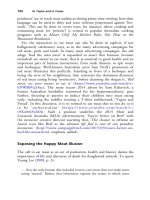The palgrave international handbook of a 245
Bạn đang xem bản rút gọn của tài liệu. Xem và tải ngay bản đầy đủ của tài liệu tại đây (26.82 KB, 1 trang )
240
J. Maher and T. Wyatt
and increasing opportunities for harm. In response, NGOs have embraced
the internet and new technology and scientific advancements to prevent and
monitor (IFAW 2008) the wildlife trade, protecting both animal and human
victims. UNEP (2014, p. 2) confirmed the benefits of technology—such as
‘acoustic traps, mobile technology, UAVs, radio frequency identification
tags, encrypted data digital networks, camera traps, DNA testing, radio
collars, metal scanners, and satellite imagery’—for rangers in source countries. Protection is enhanced through increasing the effort needed to target
the animal victims and their habitat and enabling surveillance across larger
areas with fewer resources. Importantly, this approach may prevent, rather
than just respond to, the harm. Prosecutions are also enabled through the
evidence gathered. According to Sonricker et al. (2012), for example, the
development of the HealthMap Wildlife Trade website, a digital surveillance
system, is the most comprehensive and freely accessible monitoring tool
available to support enforcement agencies. The website augments traditional
approaches by combining both official and unofficial (for example, social
networks) data generated by an automated web-crawling surveillance system.
NGOs also work in source countries (WAP), offering alternative livelihoods
to indigenous people to reduce the need to poach wildlife and to strengthen
their participation in the conservation of animals (see also REDD in Brazil).
Of the responses taken to IWT, this is the most likely to reduce abuse and
directly impact the lives of animals.
The remit of NGOs varies considerably with regard to the prevention
of abuse; while some organisations call for an end to all abuse (animal
rights perspective), others aim to improve animal welfare or conservation
of specific species and their environment. Most commonly, responses aim
to improve welfare and conservation—their focus is therefore on preventing ‘unnecessary suffering’ (see arguments against this approach in Beirne
2009). Consequently, there is little protection for individual trafficked
victims. There are also concerns over the effectiveness of conservation
programmes. Seidensticker (2010) argues that ongoing habitat destruction and poaching may simply make tiger conservation unsustainable.
The problem is more complex than simply providing funding for conservation. Rather a multifaceted and multiagency response is required that
is internationally focused on suppressing demand by changing anthropocentric attitudes towards the consumption of wildlife. Furthermore, some
strategies unhelpfully substitute the killing or harm of one animal for
another. For example, trophy hunting—highlighted in the controversial
killing of ‘Cecil the Lion’ (Guardian 2015)—has been used extensively as
a management tool to protect wildlife in South Africa (Department of









